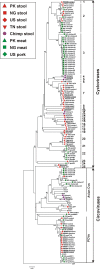Multiple diverse circoviruses infect farm animals and are commonly found in human and chimpanzee feces
- PMID: 20007276
- PMCID: PMC2812408
- DOI: 10.1128/JVI.02109-09
Multiple diverse circoviruses infect farm animals and are commonly found in human and chimpanzee feces
Abstract
Circoviruses are known to infect birds and pigs and can cause a wide range of severe symptoms with significant economic impact. Using viral metagenomics, we identified circovirus-like DNA sequences and characterized 15 circular viral DNA genomes in stool samples from humans in Pakistan, Nigeria, Tunisia, and the United States and from wild chimpanzees. Distinct genomic features and phylogenetic analysis indicate that some viral genomes were part of a previously unrecognized genus in the Circoviridae family we tentatively named "Cyclovirus" whose genetic diversity is comparable to that of all the known species in the Circovirus genus. Circoviridae detection in the stools of U.S. adults was limited to porcine circoviruses which were also found in most U.S. pork products. To determine whether the divergent cycloviruses found in non-U.S. human stools were of dietary origin, we genetically compared them to the cycloviruses in muscle tissue samples of commonly eaten farm animals in Pakistan and Nigeria. Limited genetic overlap between cycloviruses in human stool samples and local cow, goat, sheep, camel, and chicken meat samples indicated that the majority of the 25 Cyclovirus species identified might be human viruses. We show that the genetic diversity of small circular DNA viral genomes in various mammals, including humans, is significantly larger than previously recognized, and frequent exposure through meat consumption and contact with animal or human feces provides ample opportunities for cyclovirus transmission. Determining the role of cycloviruses, found in 7 to 17% of non-U.S. human stools and 3 to 55% of non-U.S. meat samples tested, in both human and animal diseases is now facilitated by knowledge of their genomes.
Figures




References
-
- Allan, G. M., and J. A. Ellis. 2000. Porcine circoviruses: a review. J. Vet. Diagn. Investig. 12:3-14. - PubMed
-
- Biagini, P. 2005. Anellovirus, p. 335-341. In C. M. Fauquet, M. A. Mayo, J. Maniloff, U. Desselberger, and L. A. Ball (ed.), Virus taxonomy. Eighth report of the International Committee on Taxonomy of Viruses. Elsevier Academic Press, San Diego, CA.
-
- Biagini, P. 2009. Classification of TTV and related viruses (anelloviruses). Curr. Top. Microbiol. Immunol. 331:21-33. - PubMed
Publication types
MeSH terms
Substances
Associated data
- Actions
- Actions
- Actions
- Actions
- Actions
- Actions
- Actions
- Actions
- Actions
- Actions
- Actions
- Actions
- Actions
- Actions
- Actions
- Actions
- Actions
- Actions
- Actions
- Actions
- Actions
- Actions
- Actions
- Actions
- Actions
- Actions
- Actions
- Actions
- Actions
- Actions
- Actions
- Actions
- Actions
- Actions
- Actions
- Actions
- Actions
- Actions
- Actions
- Actions
- Actions
- Actions
- Actions
- Actions
- Actions
- Actions
- Actions
- Actions
- Actions
- Actions
- Actions
- Actions
- Actions
- Actions
- Actions
- Actions
- Actions
- Actions
- Actions
- Actions
- Actions
- Actions
- Actions
- Actions
- Actions
- Actions
- Actions
- Actions
- Actions
- Actions
- Actions
- Actions
- Actions
- Actions
- Actions
- Actions
- Actions
- Actions
- Actions
- Actions
- Actions
- Actions
- Actions
- Actions
- Actions
- Actions
- Actions
- Actions
- Actions
- Actions
- Actions
- Actions
- Actions
- Actions
- Actions
- Actions
- Actions
- Actions
- Actions
- Actions
- Actions
- Actions
- Actions
- Actions
- Actions
- Actions
- Actions
- Actions
- Actions
- Actions
- Actions
- Actions
- Actions
- Actions
- Actions
- Actions
- Actions
- Actions
- Actions
- Actions
- Actions
- Actions
- Actions
- Actions
- Actions
- Actions
- Actions
- Actions
- Actions
- Actions
- Actions
- Actions
- Actions
- Actions
- Actions
- Actions
- Actions
- Actions
- Actions
- Actions
- Actions
- Actions
- Actions
Grants and funding
LinkOut - more resources
Full Text Sources
Other Literature Sources

